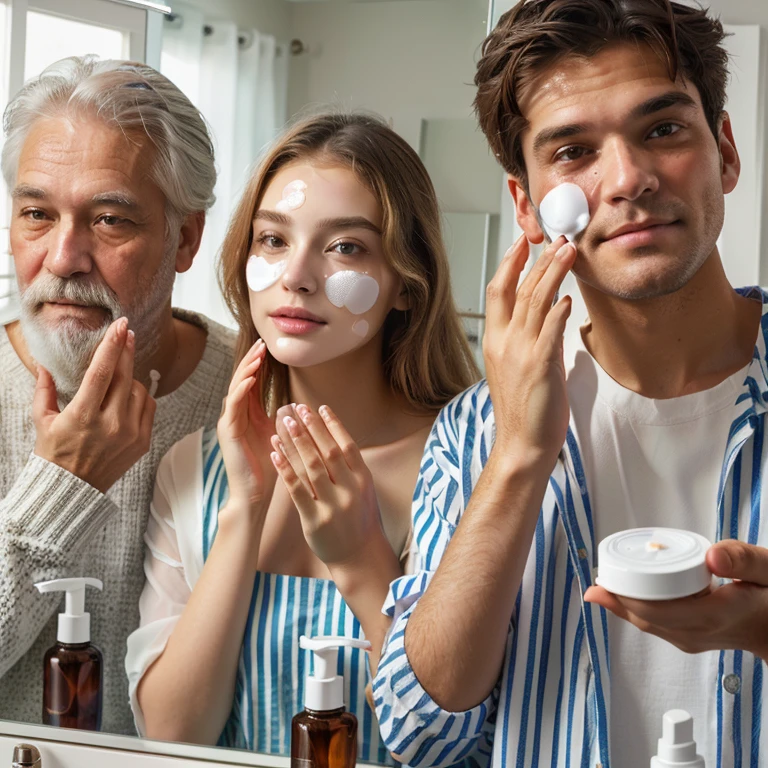This article will discuss how pimple patches work on various types of acne, by firstly discussing how acne is formed and healed.
How Does Acne Come into Formation?
Acne begins when the pores of the skin become clogged with oil and dead skin cells. This creates an ideal environment for bacteria to grow, leading to inflammation and the formation of pimples.
Hormones, particularly androgens, increase during puberty, causing the sebaceous glands to enlarge and produce more sebum. This excess oil can further exacerbate the blockage of pores.
The bacterium Propionibacterium acnes (P. acnes) is commonly found on the skin and becomes problematic when trapped in clogged pores. It can cause the pore to become inflamed, leading to the red and swollen appearance associated with acne.
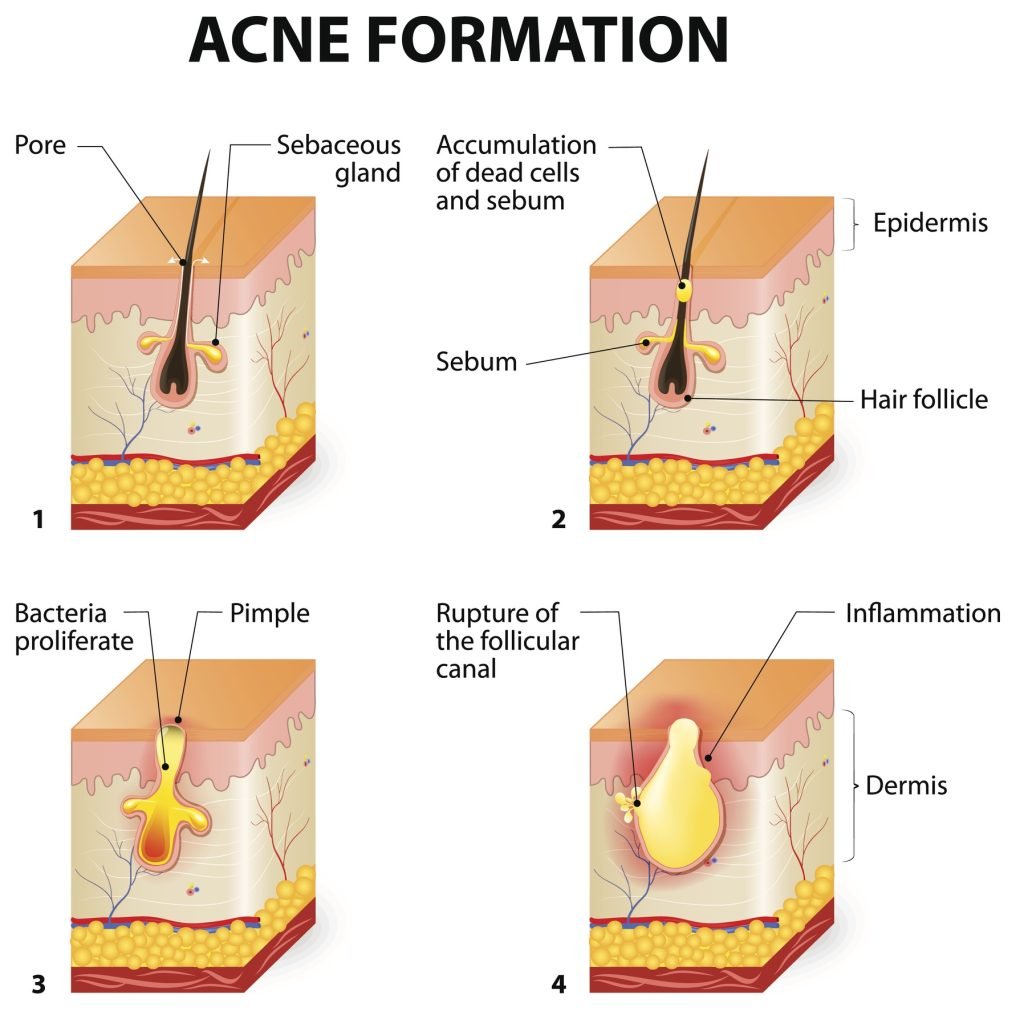
Acne forms when bacteria invade pore containing sebum, which leads to inflammation Source: Getty Image
Pimple Patches Don’t Treat Your Acne, Your Immune System Does!
While pimple patches help manage the symptoms of acne by absorbing exudate and protecting the lesion, it is actually your immune system that does the heavy lifting by fighting the bacteria and initiating the healing process.
Pimple patches can support the immune system’s function by maintaining a hygienic and protective environment over the acne spot. This prevents further bacterial contamination and allows the immune system to heal the skin more effectively.
How Does Your Immune System Work to Heal Your Acne?
As a study published on Journal of Clinical Medicine have concluded, when a pore becomes infected, the immune system sends white blood cells to attack the bacteria, which can cause inflammation and pus—a visible sign that your body is fighting the infection.
The redness and swelling associated with a healing pimple are signs of the body’s inflammatory response. While inflammation is a natural and essential part of healing, excessive inflammation can cause pain and may lead to scarring.
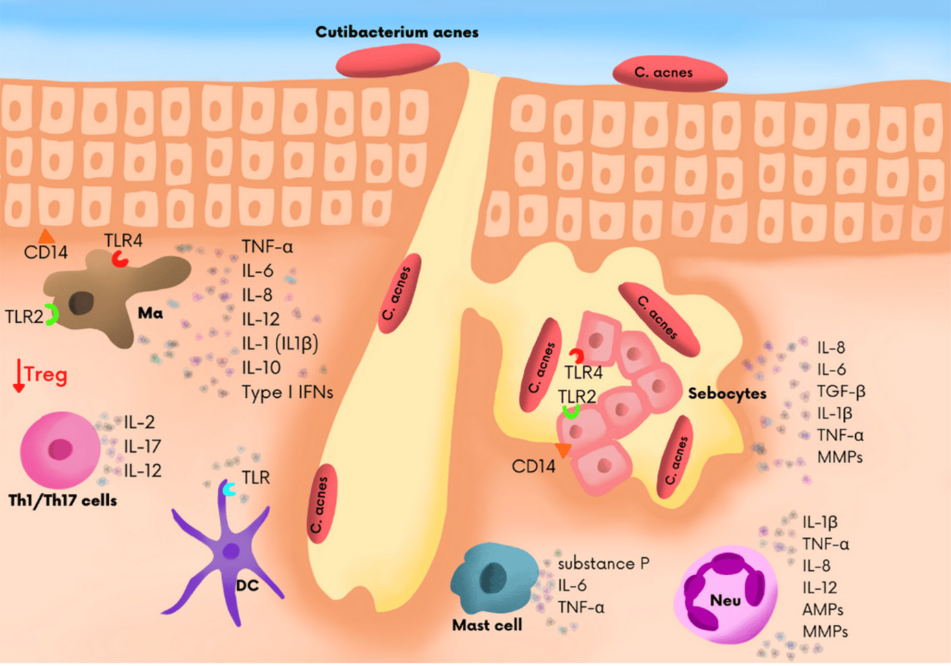
The immune cells responds to bacterial infection in skin, fighting the acne Source: JCM
How Do Pimple Patches Help Treat Acne?
Pimple patches help accelerate the process of healing acne, as some studies have shown that proper use of pimple patches can reduce time for recovery by up to 40%.
Pimple patches contain hydrocolloid material that absorbs pus and oil from the inflamed pore. By drawing out these impurities, the patch helps reduce swelling and redness, speeding up the healing process.
The patch acts as a barrier against external irritants and bacteria, protecting the acne spot from further infection and reducing the risk of scarring by minimizing the temptation to pick or squeeze the pimple. Also, by maintaining a moist environment, pimple patches prevent the acne spot from drying out and promote faster healing, aligning with the skin’s natural healing mechanisms.
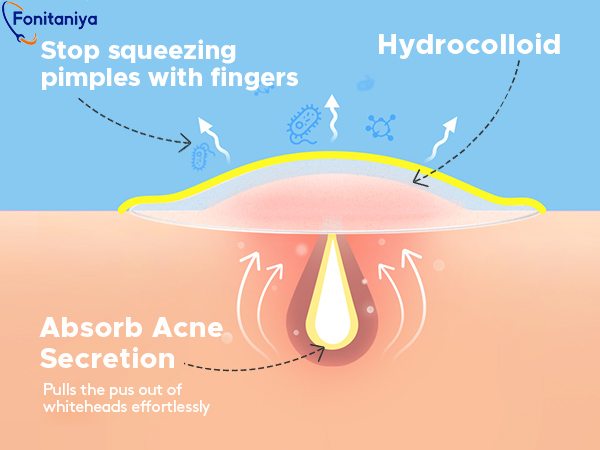
Pimple patches help the immune system by creating an ideal environment for acne healing.
Some pimple patches contain active ingredients, what are they?
Some pimple patches come infused with active ingredients such as salicylic acid, tea tree oil, or benzoyl peroxide. These components work to accelerate the healing process by providing antimicrobial and anti-inflammatory benefits, directly targeting the underlying causes of acne. These active ingredients can enhance an environment needed for healing, as they can penetrate deeper to treat the acne more effectively.
What Types of Acne Are Best Treated with Pimple Patches?
Do pimple patches work for whiteheads?
Pimple patches are most effective on superficial forms of acne such as whiteheads and pustules. These types of acne are closer to the surface, which allows the hydrocolloid material to absorb the contents effectively.
Do pimple patches work for spots?
Pimple patches work best on acne that is already inflamed and has come to a head. The patches can protect these spots from further irritation and help speed up the healing process by keeping the area clean and protected from bacteria.
Do pimple patches work on cysts?
For deeper acne like nodules and cysts, traditional pimple patches may not provide the same level of effectiveness. These forms of acne require more penetrating treatments, although specialized patches with microdart technology may offer some relief.
To learn more about if pimple patches can treat deep acne and cyst, please visit our blog here.
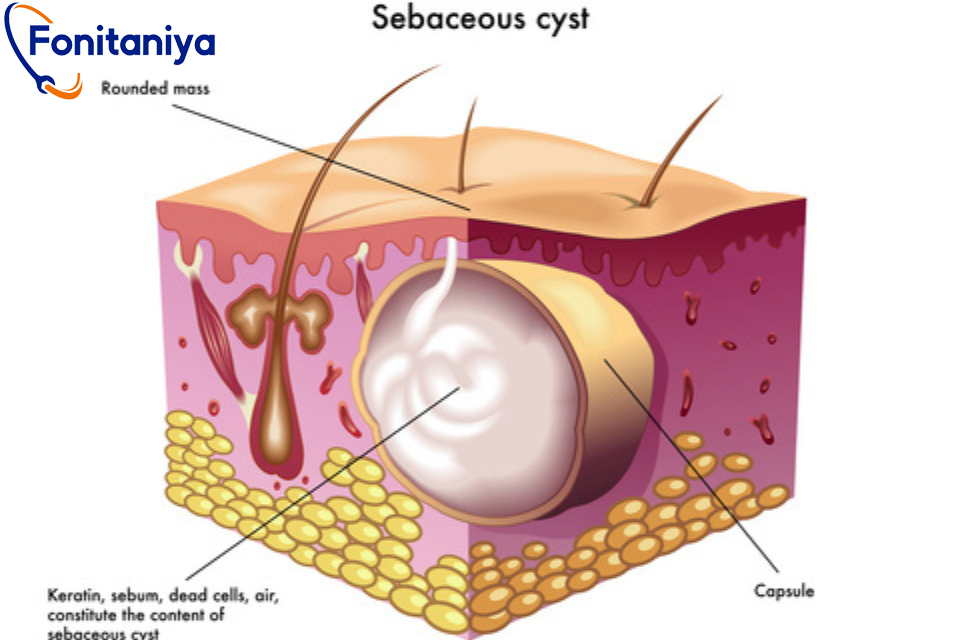
Cysts are generally deeper in the skin, so pimple patches are not always effective on dealing with cysts.
Do pimple patches work for blackheads?
Pimple patches are generally not effective on blackheads or closed comedones. These types of acne do not have a head or pus, therefore hydrocolloid cannot function like they do with surface acne. These conditions often require exfoliating or dissolving treatments instead.
Can Pimple Patches Prevent Acne Scars?
By providing a protective barrier, pimple patches can significantly reduce the temptation to pick or squeeze pimples, which is a common cause of scarring. The patches help flatten and heal the pimple without the mechanical trauma that can lead to scar formation.
Impact on Existing Inflammation
The hydrocolloid material in pimple patches can reduce the severity of post-acne marks. It works by helping the skin regenerate more efficiently, potentially reducing the appearance of scars.
Patches with active ingredients like niacinamide or salicylic acid can further aid in scar prevention by reducing inflammation and promoting healthy skin cell turnover, thereby minimizing the likelihood of permanent texture changes or pigmentation.
Limitations
Pimple patches are not a cure-all. Deep or already existing scars might require more intensive dermatological treatments such as lasers or chemical peels.

Pimple patches are widely accepted even by celebrities. Source: Daily Mail
How Long Does It Take for Pimple Patches to Work?
Pimple patches can begin to show results within just a few hours of application. Users often notice a reduction in redness and swelling shortly after applying the patch, making it an excellent option for rapid relief. For more noticeable results, leave a pimple patch on overnight. As many users report, they wake up to significantly reduced pimple size or a completely flattened lesion.
Variable Healing Times
The duration of effectiveness can vary depending on the severity and type of acne. While superficial blemishes like whiteheads may resolve quickly, more inflamed or larger pimples might require multiple applications over several days to achieve the best results. However, patches infused with active ingredients such as tea tree oil may speed up the healing process even further. These ingredients contribute to faster clearing of the acne by directly targeting bacteria and reducing inflammation.
What Should You Look for in a Pimple Patch?
Ingredient
When selecting a pimple patch, it’s important to consider the ingredients. Look for patches that contain proven acne-fighting substances like salicylic acid, tea tree oil, or benzoyl peroxide if your goal is to not only cover but also treat the acne actively.
Hydrocolloid Quality
The quality of the hydrocolloid material is crucial. A good hydrocolloid patch should be able to absorb pus and oils effectively while maintaining a secure, breathable seal over the acne lesion to prevent further infection.
Size and Thickness
Choose a patch size that covers the pimple completely but isn’t so large that it covers healthy skin, which can lead to unnecessary irritation. The thickness should also be considered; a thinner patch is usually less visible and more comfortable, especially if wearing it during the day.
Transparency and Visibility
For daytime wear, look for patches that are thin and transparent enough to go unnoticed. Some brands offer tinted or blendable patches that can be worn under makeup more seamlessly.
Skin Sensitivity
If you have sensitive skin, opt for fragrance-free and hypoallergenic pimple patches to minimize the risk of irritation. Checking for dermatologist-tested labels can also provide additional assurance of the product’s gentleness.
How Do You Use Pimple Patches Correctly?
Before applying a pimple patch, it’s crucial to cleanse your skin thoroughly to remove any oils, dirt, or makeup. This ensures that the patch can adhere properly and perform effectively.Gently press the pimple patch over the cleaned and dried acne spot. Make sure the edges stick well to the skin to create a sealed environment. This prevents bacteria from entering and promotes optimal healing conditions.For best results, wear the pimple patch for at least six to eight hours. Overnight application is ideal because it allows ample time for the patch to absorb pus and reduce inflammation without interference from external factors like touching or makeup.
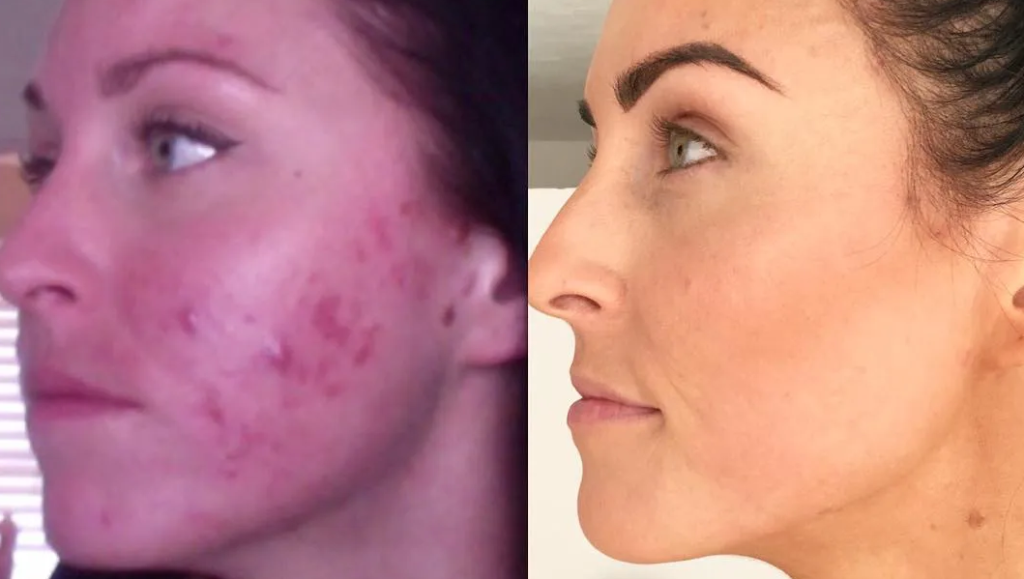
Correct usage of pimple patches accelerate the healing of acne.
What to do after removing pimple patch?
After removing the patch, gently cleanse the area again to remove any residue or exudate. Apply a gentle, non-comedogenic moisturizer to help soothe the skin and maintain hydration, especially if you have dry or sensitive skin types.
How often should I use pimple patches?
Pimple patches can be used as often as needed until the pimple resolves. However, if you notice increased irritation or no improvement after several days, consider consulting a dermatologist for further advice.
Conclusion
In conclusion, pimple patches can get rid of acne by accelerating the healing process. They offer a discreet, safe, and targeted approach to acne treatment, providing relief from inflammation and speeding up the healing process. By adhering to proper usage guidelines and choosing the right type of patch for your skin type and specific acne concerns, users can maximize the benefits with minimal side effects.
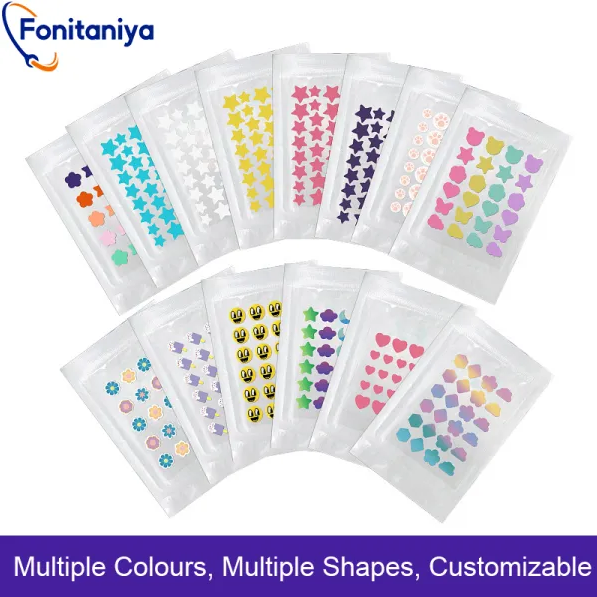
Our own DIY pimple patches tailored to meet your diverse needs.
Our brand, Fonitaniya, not only produces high-quality, skin-friendly pimple patches but also specializes in DIY pimple patches/customized hydrocolloid patches tailored to meet diverse customer needs. With over 13 years of experience in producing tapes and other adhesive products in a B2B framework, Fonitaniya keep innovating in better quality, ensuring our products stand out in the skincare market. Whether you’re looking for standard solutions or bespoke products, Fonitaniya offers reliable and effective skincare enhancements for every need.
FAQs
Can Pimple Patches Be Used on All Types of Acne?
Pimple patches are most effective on surface-level acne like whiteheads and pustules. Deeper forms of acne, such as cysts and nodules, may require more intensive treatment options, although newer microdart patches offer potential benefits for these types as well.
Are Pimple Patches Suitable for Daily Use?
Yes, pimple patches can be used daily if needed. They are designed to be gentle on the skin and can be part of a regular skincare routine, especially when dealing with frequent breakouts.
Can I Apply Makeup Over a Pimple Patch?
While some pimple patches are thin and designed to be worn under makeup, it’s generally better to apply makeup around the patch to maintain its effectiveness and adhesive properties.
Do Pimple Patches Help with Acne Scarring?
Pimple patches can help prevent acne scars by protecting the pimple from external bacteria and reducing the temptation to pick at the skin. However, existing deep scars might require more specialized treatment.
What Should I Do If a Pimple Patch Causes Irritation?
If you experience irritation or an allergic reaction to a pimple patch, remove it immediately. If irritation persists, discontinue use and consult a dermatologist to explore other acne treatment options that might be more suitable for your skin type.
Can Pimple Patches Expire?
Like most skincare products, pimple patches do have an expiration date. Using expired patches might reduce their effectiveness, so always check the packaging for the expiration date and storage instructions to ensure maximum efficacy.



